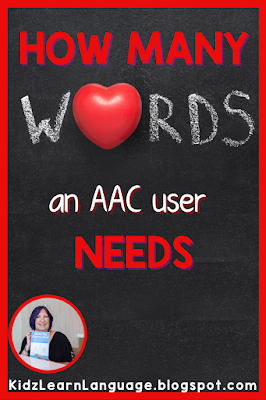The debate is still on about which words we provide to our beginning AAC users, how to organize that vocabulary in AAC systems, and how to teach AAC users to use those words?
It’s not a new debate, and you may have very strong opinions. However, in recent years there’s been a much more cohesive concept in the AAC community about what AAC systems and AAC instruction should look like.
When I do presentations around the country, I always talk about where we have been (the bad old days of whole message systems) and where we are now (with more emphasis on spontaneous utterance generation) in that discussion. How we manage this is so crucial to the individuals whom we serve.
One quote I always use that comes from Porter & Kirkland pretty much sums up the importance of this issue:
“..a child who uses speech will independently select the words she wishes from the vast array she hears/uses everyday. A child who uses aac will independently select the words she wishes to use from the vocabulary other people have chosen to model and, for aided symbols, made available for her to use.”
Which words we choose to provide will have a profound impact upon that individual’s ability to communicate what she wants, when she wants, to whom she wants.
As SLPs we need only look to the ASHA Glossary for direction:
“Communication is based on the use of individual words of our language. True communication is spontaneous and novel. Therefore, communication systems cannot be based significantly on pre-stored sentences. Communication requires access to vocabulary of individual words suitable to our needs that are multiple and subject to change. these words must be selected to form the sentences that we wish to say.”
So, core words or fringe? It is not an either or proposition. It is a matter of balance, of measuring power, and of matching to the individual.
I did a study many years ago (presented at ASHA way, way back in the 1980’s) where I analyzed language samples of the minimally verbal severely disabled students I was working with at the time. What I found was an overwhelming preponderance of nouns that provided them with little power to communicate anything more than tangible items that they wanted.
This same finding has been repeatedly seen and talked about over and over since then - and probably before then, too.
As Carole Zangari (http://praacticalaac.org/praactical/the-baby-the-bathwater-and-core-vocabulary/) so eloquently put it - let’s not throw the baby out with the bathwater.
Core vocabulary is powerful. It contains the words we use to communicate the many messages that are i important to us. And for students who often want mostly to tell us to go away, leave them alone, give them a break, provide something different, or tell us what is bothering them, a vocabulary of nouns is rarely powerful enough.
But let’s not forget the words they need to talk about their family and pets, their environment and activities, and - invariably - the things they want.
So, I’ll end with another quote - and a FREEBIE - and a different metaphor - this time from Janice Light - “There is more to life than cookies.”
And the freebie? Here is an early core word communication board to get you started with students who may not already have aac systems.
This is the perfect time of year to get started building more vocabulary. Kids “want” food and presents and more, of course they want “more” of all those things - not to mention more hugs, more songs, more fun - “no” to the things they don’t like, “stop” to their siblings who might grab and push, “like” is the perfect comment to the great times with families and friends, and “love” is the one word we all want to hear.
Keep on talking!




I appreciate your writing skill. Please keep on working hard
ReplyDeleteclipping path service